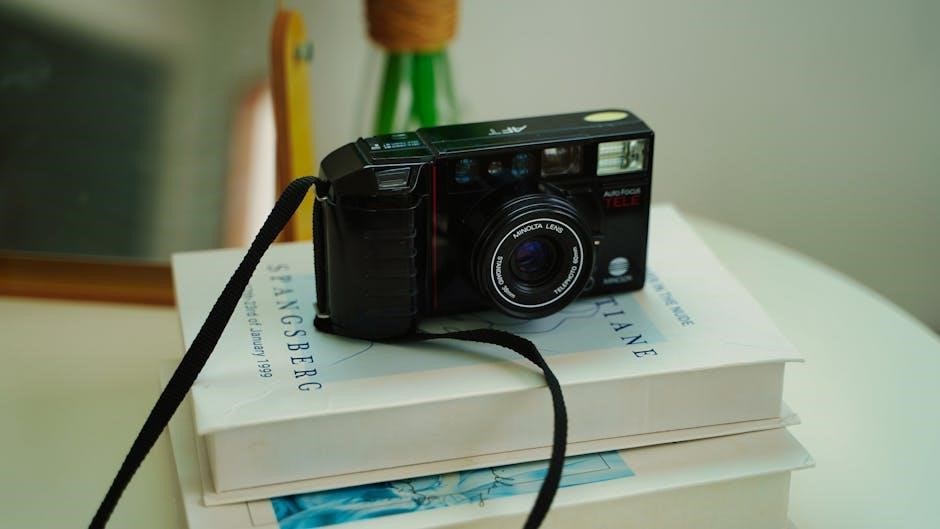minolta maxxum 7000 owners manual
The Minolta Maxxum 7000 is a groundbreaking SLR camera that introduced advanced autofocus and computerized features‚ making it user-friendly for both professionals and enthusiasts. Its owner’s manual is essential for mastering its functions‚ ensuring optimal performance and creativity in photography.
1.1 Overview of the Minolta Maxxum 7000 Camera
The Minolta Maxxum 7000 is a pioneering SLR camera released in 1985‚ known for being the first to feature in-camera autofocus. It combines advanced computerized technology with user-friendly controls‚ offering modes like Program‚ Aperture Priority‚ and Manual. The camera supports interchangeable lenses and accessories‚ making it versatile for various photography needs. Its owner’s manual is crucial for understanding its operation‚ ensuring photographers can fully utilize its capabilities‚ from film loading to exposure settings‚ and explore its compatibility with motor drives and tripods. This camera’s innovative design and functionality have left a lasting impact on the photography industry.
1.2 Key Innovations in the Minolta Maxxum 7000
The Minolta Maxxum 7000 introduced groundbreaking features‚ including the world’s first in-camera autofocus system‚ predictive focus control‚ and a multi-mode exposure system. It offered Program‚ Aperture Priority‚ Shutter Priority‚ and Manual modes‚ catering to both professionals and enthusiasts. The camera also featured a built-in flash and motor drive compatibility‚ enhancing versatility. Its innovative design and user-friendly interface set a new standard in SLR photography‚ making it a landmark device in the industry.
1.3 Importance of the Owners Manual
The owner’s manual is crucial for maximizing the potential of the Minolta Maxxum 7000. It provides detailed guidance on operating the camera’s advanced features‚ such as autofocus‚ exposure modes‚ and film handling. The manual ensures users understand how to use the camera’s predictive focus control‚ multiple autofocus modes‚ and motor drive functions effectively. By following the manual‚ photographers can unlock the camera’s full capabilities‚ enhancing their creative control and shooting experience. It serves as an essential reference for both beginners and experienced photographers alike.
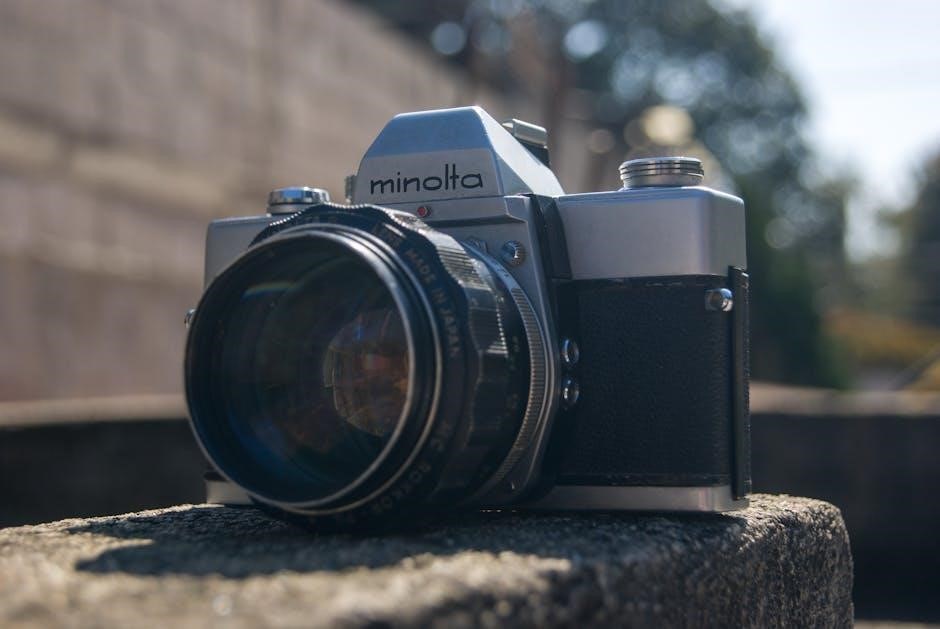
Key Features of the Minolta Maxxum 7000
The Minolta Maxxum 7000 boasts advanced autofocus‚ PASM modes‚ and precise film handling. Its predictive focus control and multiple metering modes enhance creativity and technical accuracy in photography.
2.1 Autofocus System and Its Capabilities
The Minolta Maxxum 7000 features an advanced autofocus system with predictive focus control‚ enabling precise tracking of moving subjects. It uses multiple sensors for accurate focus acquisition and offers continuous AF for dynamic shooting situations. The system is highly responsive‚ ensuring sharp images even in challenging lighting conditions. Additionally‚ it supports manual focus override‚ allowing photographers to refine focus adjustments as needed. This versatile autofocus system is a cornerstone of the camera’s functionality‚ as detailed in the owner’s manual.
2.2 PASM Modes (Program‚ Aperture Priority‚ Shutter Priority‚ Manual)
The Minolta Maxxum 7000 offers four exposure modes: Program (P)‚ Aperture Priority (A)‚ Shutter Priority (S)‚ and Manual (M). Program mode automates settings for quick shooting‚ while Aperture Priority allows control over depth of field. Shutter Priority enables control over motion capture‚ and Manual mode provides full creative control. These modes cater to both beginners and advanced photographers‚ ensuring versatility in various lighting conditions. The owner’s manual details each mode’s operation and application for optimal results.
2.3 Film Handling and Loading Process
Properly loading film into the Minolta Maxxum 7000 ensures smooth operation. Open the camera back by releasing the latch‚ align the film leader with the take-up spool‚ and gently advance the film. Close the back and advance to the first frame. The camera automatically advances film between shots. Always handle film in low light‚ keep it in the cassette until loading‚ and avoid touching the emulsion side to prevent damage. The owner’s manual provides detailed steps for accurate film loading.
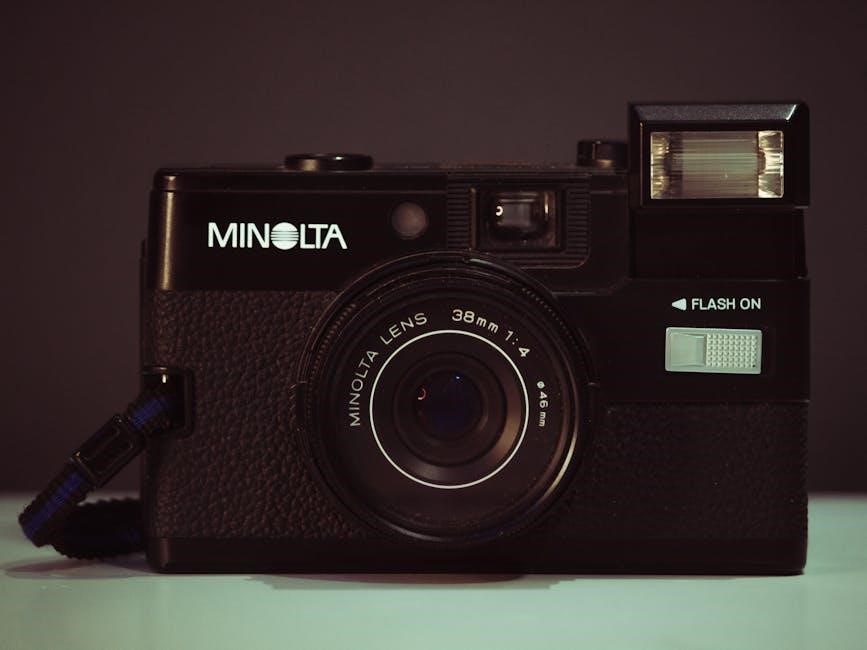
How to Use the Minolta Maxxum 7000 Manual
The Minolta Maxxum 7000 manual is essential for understanding the camera’s features. Available in PDF‚ it covers autofocus‚ PASM modes‚ and film handling‚ ensuring optimal use.
3.1 Navigating the Manual for Easy Understanding
The Minolta Maxxum 7000 manual is designed to help users navigate its features with ease. The PDF guide includes a detailed table of contents‚ making it simple to locate specific sections. Clear instructions cover autofocus‚ PASM modes‚ and film handling‚ while troubleshooting tips address common issues. The manual’s structured format ensures photographers can quickly find the information they need‚ whether they’re beginners or experienced shooters.
3.2 Quick Start Guide for Beginners
The manual provides a Quick Start Guide to help new users master the Minolta Maxxum 7000. It covers the basics of camera operation‚ including attaching lenses‚ loading film‚ and setting shooting modes. The guide simplifies complex features‚ offering step-by-step instructions for capturing stunning images. Designed for quick reference‚ it ensures photographers can start shooting confidently‚ even if they’re unfamiliar with the camera’s advanced functionalities.
3.3 Advanced Features Explained in the Manual
The manual thoroughly explains the Minolta Maxxum 7000’s advanced features‚ such as predictive focus control‚ multiple autofocus modes‚ and motor drive compatibility. It provides detailed instructions on using these technologies to enhance photography. The guide also covers customizable settings‚ allowing photographers to tailor the camera to their preferences. By exploring these features‚ users can unlock the camera’s full potential and achieve professional-grade results in various shooting scenarios.
Technical Specifications of the Minolta Maxxum 7000
The Minolta Maxxum 7000 features a 35mm film format‚ predictive focus control‚ and compatibility with the Motor Drive MD-90‚ showcasing its advanced engineering and versatility.
4.1 Camera Body and Build Quality
The Minolta Maxxum 7000 boasts a durable camera body constructed from high-quality materials‚ ensuring longevity and reliability. Its ergonomic design provides a comfortable grip‚ enhancing usability. The camera features a sturdy metal chassis with polycarbonate exterior‚ offering a balance of strength and lightweight portability. Weather-sealing and moisture-resistant properties further protect internal components‚ making it suitable for various shooting environments. Its robust build quality ensures precise mechanical operations and lasting performance for photographers.
4.2 Lens Compatibility and Mount Type
The Minolta Maxxum 7000 utilizes the Minolta A-type bayonet mount‚ ensuring compatibility with a wide range of Minolta AF lenses. This system supports seamless communication between the camera and lenses‚ enhancing autofocus and metering accuracy. The manual details how to attach and use various lenses effectively‚ including zoom‚ prime‚ and specialized lenses. Its compatibility with Minolta’s extensive lens lineup makes it versatile for diverse photography needs‚ from portraits to landscapes.
4.3 Shutter Speed and ISO Range
The Minolta Maxxum 7000 offers a versatile shutter speed range of 30 seconds to 1/4000th of a second‚ catering to various photographic needs. The ISO range supports film speeds from ISO 25 to ISO 5000‚ accommodating different lighting conditions. The camera’s manual provides detailed guidance on selecting the appropriate film speed and utilizing the shutter speeds effectively‚ ensuring optimal exposure control for high-quality images.
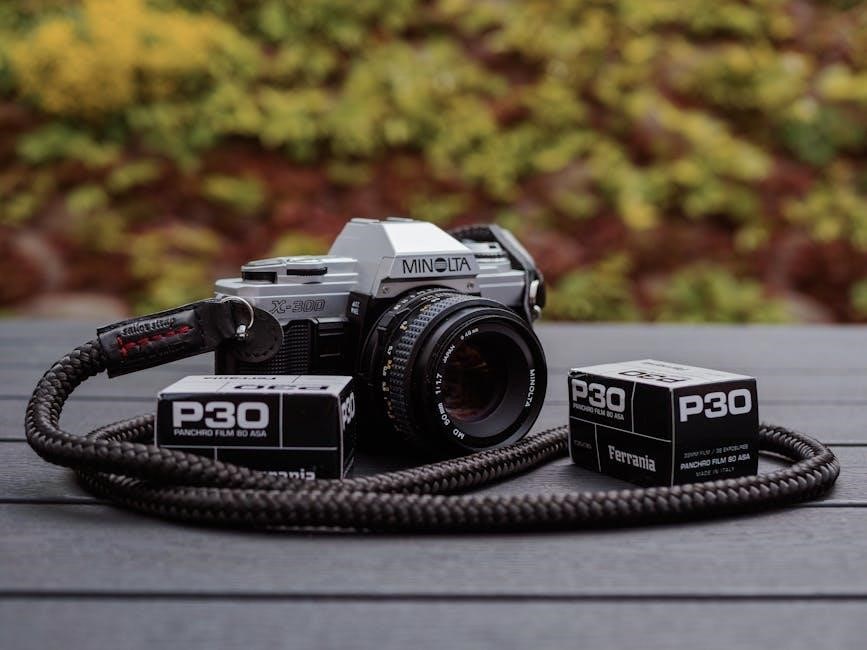
Loading Film in the Minolta Maxxum 7000
Proper film loading is crucial for the Minolta Maxxum 7000. Ensure the camera is ready‚ use film advance mode‚ align film correctly‚ and follow the manual’s guidance for trouble-free shooting;
5.1 Step-by-Step Film Loading Process
Ensure the camera is turned off and the lens is removed.
Open the film compartment by sliding the latch on the rear.
Align the film leader with the red mark inside.
Gently pull the film across to the take-up spool.
Close the compartment and advance the film using the rewind knob.
Confirm the film counter shows “1” to start shooting.
Follow these steps carefully to ensure proper film loading and avoid issues.
5.2 Film Advance Modes and Their Functions
The Minolta Maxxum 7000 offers two film advance modes: Single Frame Advance and Continuous Shooting.
In Single Frame mode‚ the camera advances one frame per shutter press‚ ideal for precise control.
Continuous Shooting mode allows for rapid firing at up to 2 frames per second‚ perfect for capturing action sequences.
Additionally‚ the camera features a Bulb Mode for long exposures‚ enabling manual control over frame advance in low-light conditions.
These modes enhance flexibility‚ catering to various photographic needs and shooting styles.
5.3 Tips for Proper Film Handling
Always load film in a dark environment or use a changing bag to prevent light exposure.
Avoid touching the film’s sensitive surfaces to minimize fingerprints and scratches.
Store film in a cool‚ dry place to maintain quality and prevent degradation.
Ensure the film is properly seated in the camera to avoid misalignment and improper winding.
Never expose loaded film to extreme temperatures or humidity for extended periods.
These practices ensure optimal performance and image quality when using the Minolta Maxxum 7000.
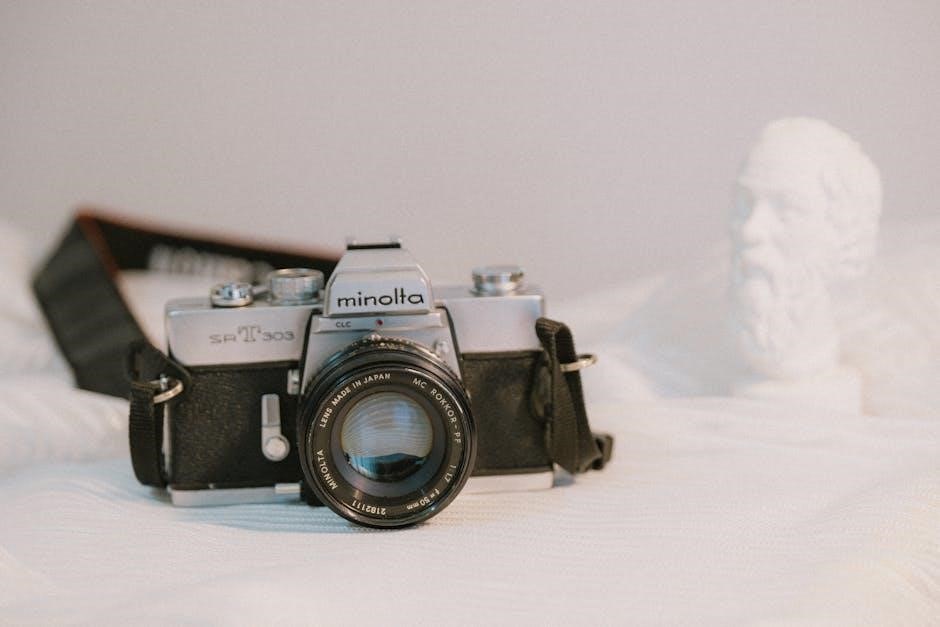
Exposure Modes and Settings
The Minolta Maxxum 7000 offers four exposure modes—Program‚ Aperture Priority‚ Shutter Priority‚ and Manual—providing photographers with precise control over aperture and shutter speed settings.
6.1 Understanding Program Mode (P)
Program Mode (P) on the Minolta Maxxum 7000 offers a fully automatic setting‚ ideal for quick and effortless photography. The camera adjusts both aperture and shutter speed to ensure optimal exposure‚ making it perfect for beginners or situations requiring fast adjustments. This mode allows for minimal user input while delivering balanced results. The owner’s manual provides detailed guidance on utilizing Program Mode effectively‚ ensuring photographers can focus on composition and creativity without manual adjustments.
6.2 Using Aperture Priority Mode (A)
Aperture Priority Mode (A) on the Minolta Maxxum 7000 allows photographers to set the aperture manually‚ while the camera automatically adjusts the shutter speed for optimal exposure. This mode is ideal for controlling depth of field—larger apertures (lower f-numbers) blur the background‚ while smaller apertures (higher f-numbers) keep more of the image in focus. The owner’s manual explains how to access this mode via the mode dial and adjust aperture using the command dial. It also details how exposure compensation can fine-tune brightness without altering the aperture‚ ensuring creative control over lighting and composition.
6.3 Mastering Shutter Priority Mode (S)
Shutter Priority Mode (S) on the Minolta Maxxum 7000 enables photographers to manually set the shutter speed‚ with the camera automatically adjusting the aperture for proper exposure. This mode is perfect for capturing motion—faster shutter speeds freeze action‚ while slower speeds create motion blur. The owner’s manual guides users on accessing this mode via the mode dial and adjusting shutter speed using the command dial. It also explains how to use exposure compensation for refining brightness‚ ensuring precise control over dynamic photography scenarios like sports or low-light conditions.
6.4 Manual Mode (M) for Full Control
Manual Mode (M) on the Minolta Maxxum 7000 offers full creative control by allowing photographers to set both aperture and shutter speed manually. This mode is ideal for situations requiring precise adjustments‚ such as portraits or landscapes. The owner’s manual details how to access Manual Mode via the mode dial and adjust settings using the command dial. It also explains how to use the exposure compensation feature to fine-tune results‚ ensuring complete control over the photographic process.

Autofocus and Metering Systems
The Minolta Maxxum 7000 features an advanced autofocus system with predictive focus control and multiple metering modes‚ ensuring precise exposures. The owner’s manual details how to utilize these systems effectively for sharp‚ well-exposed images in various lighting conditions.
7.1 How the Autofocus System Works
The Minolta Maxxum 7000’s advanced autofocus system uses infrared technology to measure distances accurately. When activated‚ the camera emits an infrared beam to calculate the distance between the lens and the subject. This data is processed to adjust the lens focus swiftly and precisely. The system supports multiple autofocus modes‚ enhancing flexibility in various shooting scenarios. The owner’s manual provides detailed guidance on optimizing these features for different photography situations.
7;2 Metering Modes (Spot‚ Center-Weighted‚ Matrix)
The Minolta Maxxum 7000 features three metering modes: Spot‚ Center-Weighted‚ and Matrix. Spot metering measures light from a specific area‚ ideal for high-contrast scenes. Center-Weighted emphasizes the central part of the frame‚ suitable for portraits. Matrix metering evaluates the entire scene for balanced exposure. The owner’s manual details how to select these modes‚ ensuring precise control over exposure settings for various lighting conditions.
7.3 Predictive Focus Control Explained
The Minolta Maxxum 7000’s Predictive Focus Control is a revolutionary feature that anticipates the movement of subjects. Using advanced algorithms‚ it calculates the position of a moving object at the exact moment of exposure‚ ensuring sharp focus. This mode is particularly effective for capturing fast-moving subjects like athletes or wildlife. The owner’s manual provides detailed instructions on activating and utilizing this feature for precise results in dynamic shooting scenarios.
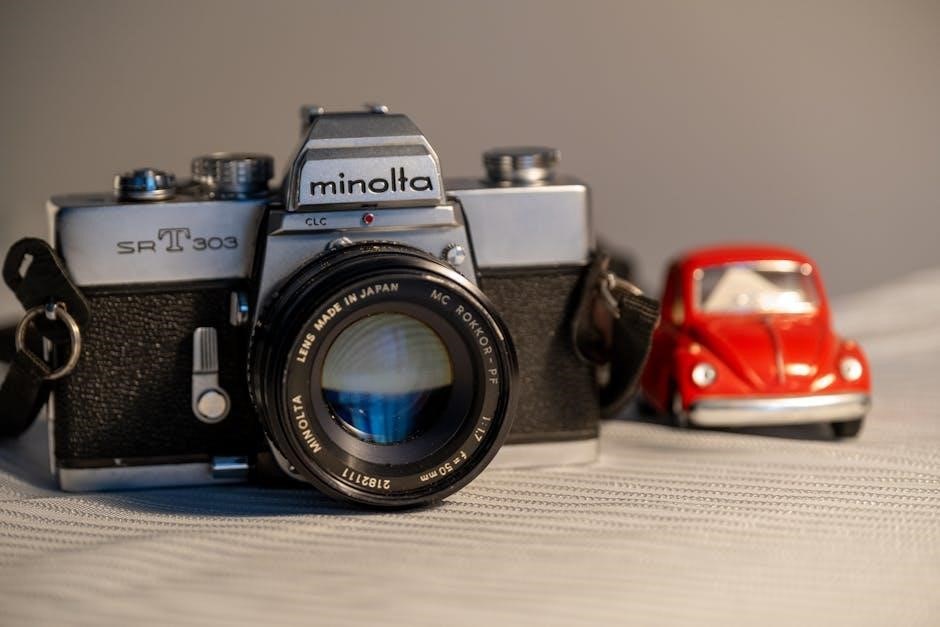
Accessories for the Minolta Maxxum 7000
The Minolta Maxxum 7000 supports a variety of accessories‚ including optional lenses‚ motor drives‚ and compatible tripods and flash units‚ enhancing its functionality for diverse photography needs.
8.1 Optional Lenses and Their Compatibility
The Minolta Maxxum 7000 is compatible with a wide range of Minolta AF lenses‚ including the popular 50mm f/1.7 and 70-210mm f/4 zoom. These lenses are designed to leverage the camera’s autofocus system‚ ensuring sharp and precise images. Additionally‚ third-party lenses with the Minolta AF mount can also be used‚ expanding creative possibilities. The owner’s manual provides detailed guidance on lens attachment and compatibility‚ ensuring optimal performance and versatility for photographers of all levels. Proper lens selection enhances the camera’s functionality and image quality.
8.2 Motor Drive and Other Accessories
The Minolta Maxxum 7000 supports optional accessories like the Motor Drive MD-90‚ enhancing shooting speed and convenience. This accessory enables rapid film advancement‚ ideal for action photography. Additionally‚ other compatible accessories include remote shutters and data backs‚ which expand the camera’s functionality. The owner’s manual provides instructions for attaching and using these accessories‚ ensuring seamless integration with the camera’s advanced features. These add-ons cater to diverse photography needs‚ offering professionals and enthusiasts enhanced control and efficiency in their work.
8.3 Recommended Tripods and Flash Units
A sturdy tripod is essential for stabilizing the Minolta Maxxum 7000‚ especially with heavy lenses or low-light conditions. The Minolta 5600HS(D) flash unit is highly recommended for balanced lighting and wireless flash control. These accessories enhance the camera’s functionality‚ ensuring sharp images and optimal lighting. The owner’s manual provides detailed guidance on setting up and using these accessories‚ helping photographers achieve professional results in various shooting scenarios.
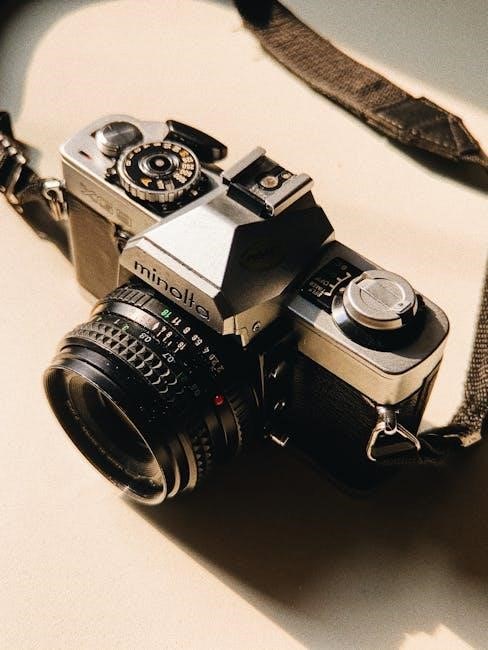
Maintenance and Troubleshooting
Regular cleaning and check-ups ensure optimal performance. Common issues include shutter lag and error messages. Consult the owner’s manual for solutions or seek professional repair if problems persist.
9.1 Cleaning and Maintenance Tips
Regular maintenance ensures the Minolta Maxxum 7000 performs optimally. Use a soft‚ dry cloth to clean the lens and camera body. Avoid harsh chemicals or abrasive materials. Check for dust on mirrors and sensors‚ and clean gently if necessary. Store the camera in a cool‚ dry place to prevent moisture damage. Refer to the owner’s manual for detailed cleaning instructions and avoid opening the camera to prevent internal damage.
9.2 Common Issues and Their Solutions
Common issues with the Minolta Maxxum 7000 include autofocus errors and film loading problems. For autofocus issues‚ ensure the lens is properly attached and clean the sensors. If film loading fails‚ check the film alignment and rewind the film before reloading. For persistent problems‚ refer to the owner’s manual or consult professional repair services to maintain optimal functionality and extend the camera’s lifespan.
9.3 When to Seek Professional Repair
If the Minolta Maxxum 7000 experiences mechanical failures‚ internal damage‚ or persistent errors despite troubleshooting‚ seek professional repair. Issues like faulty shutters‚ damaged mirrors‚ or corrupted electronics require specialized tools and expertise. Additionally‚ if the predictive focus control or film advance system malfunctions irreparably‚ consult a certified technician to restore functionality and ensure the camera’s longevity. Always refer to the owner’s manual for guidance before seeking external assistance.
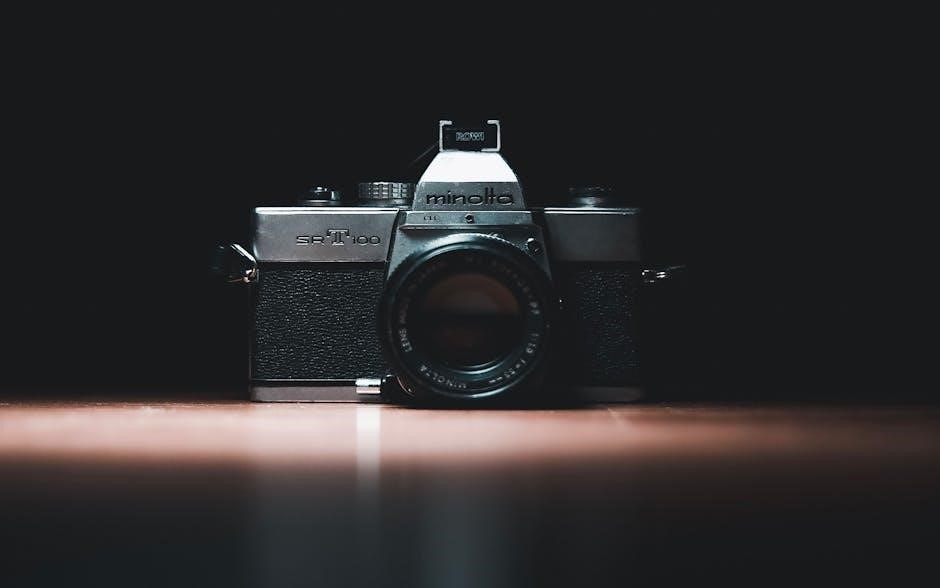
The History of the Minolta Maxxum 7000
The Minolta Maxxum 7000‚ released in 1985‚ was a groundbreaking SLR camera that introduced in-body autofocus‚ revolutionizing photography. Its innovative design and technology left a lasting legacy.
10.1 Development and Release of the Camera
The Minolta Maxxum 7000‚ released in 1985‚ was the first SLR camera to feature in-body autofocus‚ marking a significant milestone in photography. Its development introduced predictive focus control and advanced metering systems‚ making it a favorite among professionals and enthusiasts. The owner’s manual played a crucial role in helping users master its innovative features‚ ensuring optimal performance and creativity. This camera’s release not only revolutionized the industry but also left a lasting legacy in the world of photography.
10.2 Impact on the Photography Industry
The Minolta Maxxum 7000 revolutionized photography by introducing the first in-body autofocus system‚ setting a new standard for SLR cameras. Its innovative technology made it accessible to both professionals and enthusiasts‚ influencing the development of future cameras. The autofocus feature significantly sped up workflows‚ while its advanced metering systems enhanced image quality. This camera’s impact was profound‚ democratizing high-end photography features and leaving a lasting legacy in the industry.
10.3 Legacy and Popularity Among Photographers
The Minolta Maxxum 7000 remains a landmark camera‚ celebrated for its innovative autofocus system and user-friendly design. Its popularity endures among photographers‚ who praise its durability and intuitive controls. The camera’s predictive focus control and advanced metering systems solidified its place in photography history. Today‚ it is still sought after by enthusiasts and collectors‚ with its manual widely referenced‚ showcasing its lasting relevance and the strong community of photographers who cherish it.
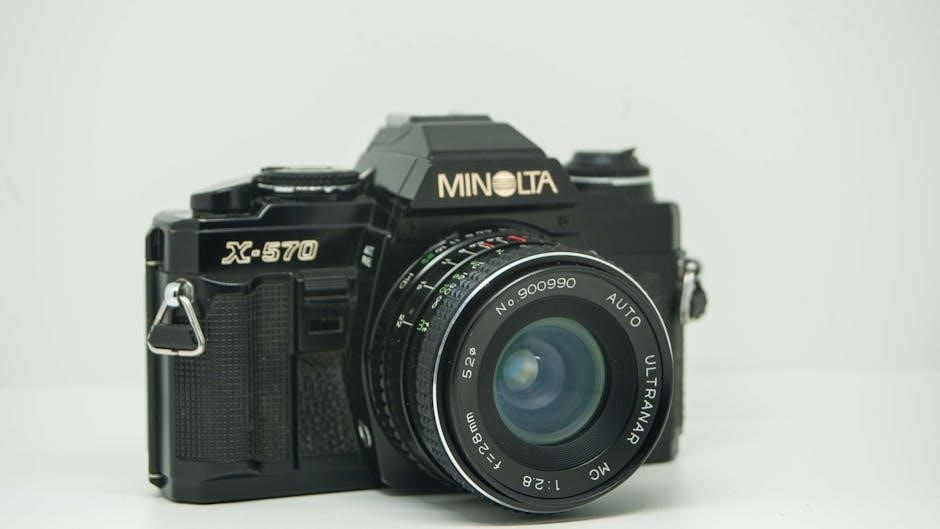
Compatible Lenses and Accessories
The Minolta Maxxum 7000 supports a wide range of AF lenses and accessories‚ including motor drives and tripods‚ enhancing functionality for photographers.
11.1 Popular Minolta AF Lenses for the Maxxum 7000
The Minolta Maxxum 7000 is compatible with a variety of AF lenses‚ including the popular 50mm f/1.7‚ 70-210mm f/4 zoom‚ and others‚ ensuring versatility for photographers.
11.2 Third-Party Lens Compatibility
The Minolta Maxxum 7000 supports third-party lenses via adapters‚ expanding compatibility with modern systems. Adapters like the LA-EA4 enable use of full-frame lenses on E-mount cameras‚ preserving optical quality and functionality‚ while maintaining the camera’s legacy in digital photography.
11.3 Accessories for Enhanced Functionality
Enhance your Minolta Maxxum 7000 experience with accessories like motor drives‚ tripods‚ and flash units. The Motor Drive MD-90 enables rapid shooting‚ while tripods ensure stability for sharp images. Flash units provide additional lighting control‚ optimizing exposure. These accessories‚ detailed in the owner’s manual‚ help maximize the camera’s potential‚ catering to both casual and professional photographers seeking versatility and precision in their work.
